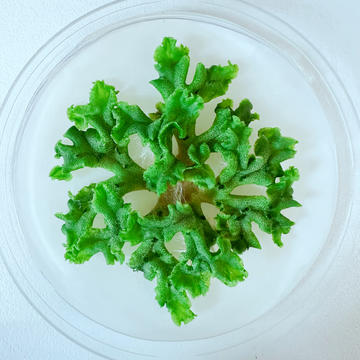Life works through the interactions of the thousands of different proteins that exist in cells. Interactions are often highly specific, largely because protein shapes can be flexible – in three dimensions, the same string of amino acids can be folded and curved in many ways. This specificity is key, yet there are very few studies exploring how it has evolved.

A liverwort (bryophyte) Marchantia polymorpha, from an ancient plant lineage and the source of the ‘ancestral’ SLY1 representative in the study
Image: Nick Harberd
New research led by Dr Zhe Ji and Professor Nick Harberd has explored these interactions in the context of plant growth, giving us new insights into how evolution has enhanced its regulation in response to environmental change.
Flowering plants (angiosperms) are prompted to grow when a growth-repressing protein, DELLA, interacts with another protein, SLY1. This interaction depends on DELLA changing shape, which happens when it encounters the plant growth hormone gibberellin (GA), altering DELLA from an A form into an A’ alternative. SLY1 then binds specifically to A’, and not to A. This specific binding eventually results in destruction of the growth-repressing DELLA protein, resulting in promotion of plant growth.
The specificity of the SLY1–A’ interaction is unique to relatively recently arisen land plants, such as the angiosperms, and not of the ancestors from which they evolved. The team developed an innovative technique, applying yeast genetics methods to select for mutant SLY1 proteins which don’t have this characteristic specificity – having affinity for both A and A’. These mutant proteins are effectively evolutionarily revertant, having ancestral rather than angiosperm SLY1 properties. Dr Ji said:
“The real surprise from our work was that we successfully used yeast genetics to reverse the processes of evolution.”
The experiments indicated that whilst the angiosperm SLY1 has specific A’ affinity, the ancestral SLY1 had dual affinity for both A and A’. Proteins are built from a sequence of amino acids; the project identified the evolutionary change of identity of particular amino acids that caused the evolution towards A’ specificity.
This increased regulatory complexity over evolutionary time has enabled plants to respond with greater sensitivity to fluctuations in the environment, such as short-term fluctuation in light and temperature. Professor Harberd said:
“These findings are important because they show how evolution shaped a protein-protein interaction that enhances the regulation of plant growth in response to environmental change. More broadly, they suggest that narrowing of affinity from broad to specific may be a general mechanism for the evolution of the protein-protein interactions that drive life.”
To read more about this research, published in Nature Plants, visit: https://www.nature.com/articles/s41477-023-01556-0